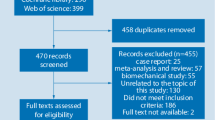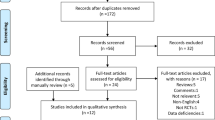Abstract
The choice between dynamic screw-intramedullary nail (DSIN) devices and dynamic screw-plate (DSP) devices for the fixation of unstable trochanteric fractures remains controversial. This study presents a meta-analysis of fixation failures in unstable trochanteric femoral fractures using DSP devices or DSIN devices. Two independent assessors selected randomised controlled trials using a range of electronic databases, as well as reference lists of selected articles. A study quality checklist was used. The occurrence of fixation failure, in particular cut-out, was the primary subject of analysis using descriptive statistics and random-effect meta-analyses. Seventeen trials were identified. Meta-analyses showed no significant difference in the frequency of implant-related complications between the two types of devices. Iatrogenic femoral fractures associated with the use of DSIN devices represent a rare, but persistent, risk. There was a tendency for less frequent cut-out with intramedullary devices compared with DSP devices.
Résumé
Le choix entre clou centro-médullaire avec vis dynamique et vis-plaque dynamique pour la fixation des fractures trochantériennes instables reste controversé. Cette étude présente une méta-analyse d'échecs de la fixation des fractures trochantériennes instables utilisant ces deux procédés. Deux observateurs indépendants ont selectioné des études cliniques randomisées utilisant plusieurs bases de données électroniques, aussi bien que les listes de référence des articles sélectionnés. Une liste de contrôle de la qualité de l'étude a été utilisée. L'événement d'échec de la fixation, en particulier la protrusion articulaire, était le sujet fondamental d'analyse. Dix-sept études cliniques randomisées ont été identifiées. La méta-analyse n'a montré aucune différence notable dans la fréquence des complications liées à l'implant entre les deux types de matériel. Les fractures fémorales iatrogène associées à l'usage de matériel centro-médullaire représentent un risque rare, mais persistant. Il y avait une tendance à des protrusions articulaires moins fréquents avec le système intramédullaire comparé avec les vis-plaque dynamiques.

Similar content being viewed by others
References
Adams CI, Robinson CM, Court-Brown CM, McQueen MM (2001) Prospective randomized controlled trial of an intramedullary nail versus dynamic screw and plate for intertrochanteric fractures of the femur. J Orthop Trauma 15:394–400
Ahrengart L, Tornkvist H, Fornander P, Thorngren KG, Pasanen L, Wahlstrom P, Honkonen S, Lindgren U (2002) A randomized study of the compression hip screw and Gamma nail in 426 fractures. Clin Orthop 209–222
Baumgaertner MR, Curtin SL, Lindskog DM (1998) Intramedullary versus extramedullary fixation for the treatment of intertrochanteric hip fractures. Clin Orthop 348:87–94
Bridle SH, Patel AD, Bircher M, Calvert PT (1991) Fixation of intertrochanteric fractures of the femur. A randomised prospective comparison of the gamma nail and the dynamic hip screw. J Bone Joint Surg [Br] 73:330–334
Butt MS, Krikler SJ, Nafie S, Ali MS (1995) Comparison of dynamic hip screw and gamma nail: a prospective, randomized, controlled trial. Injury 26:615–618
Egger M, Smith GD, O'Rourke K (2001) Rationale, potentials, and promise of systematic reviews. In: Egger M, Smith G D, Altman DG (eds) Systematic Reviews in Health Care—meta-analysis in context. BMJ Publishing, London pp 3–19
Egger M, Smith GD, Phillips AN (1997) Meta-analysis: principles and procedures. BMJ 315:1533–1537
Fornander P, Thorngren K-G, Törnqvist H, Ahrengart L, Lindgren U (1994) Swedish experience with the Gamma nail versus sliding hip screw in 209 randomised cases. Int J Orthop Trauma 4:118–122
Gehrchen PM, Nielsen JO, Olesen B (1993) Poor reproducibility of Evans' classification of the trochanteric fracture. Assessment of 4 observers in 52 cases. Acta Orthop Scand 64:71–72
Goldhagen PR, O'Connor DR, Schwarze D, Schwartz E (1994) A prospective comparative study of the compression hip screw and the gamma nail. J Orthop Trauma 8:367–372
Guyer P, Landolt M, Keller H, Eberle C (1993) The Gamma nail in per- and intertrochanteric femoral fractures—alternative or complementary to the DHS? A prospective randomised study. In: Marti R K, Dunki Jacobs P B (eds) Proximal femoral fractures—operative technique and complications. Medical Press, London pp 481–498
Hardy DC, Descamps PY, Krallis P, Fabeck L, Smets P, Bertens CL, Delince PE (1998) Use of an intramedullary hip-screw compared with a compression hip-screw with a plate for intertrochanteric femoral fractures. A prospective, randomized study of one hundred patients. J.Bone Joint Surg [Am] 80:618–630
Harrington P, Nihal A, Singhania AK, Howell FR (2002) Intramedullary hip screw versus sliding hip screw for unstable intertrochanteric femoral fractures in the elderly. Injury 33:23–28
Hoffmann R, Schmidmaier G, Schulz R, Schutz M, Sudkamp NP (1999) [Classic nail versus DHS. A prospective randomised study of fixation of trochanteric femur fractures]. Unfallchirurg 102:182–190
Johnstone DJ, Radford WJ, Parnell EJ (1993) Interobserver variation using the AO/ASIF classification of long bone fractures. Injury 24:163–165
Koval KJ, Zuckerman JD (2000) Hip fractures—a practical guide to management. Springer, Berlin Heidelberg New York
Kukla C, Heinz T, Berger G, Kwasny O, Rosenberger A, Vécsei V (1997) Gamma nail vs. dynamic hip screw in 120 patients over 60 years—a randomized trial. Acta Chir Austriaca 290–293
Kyle RF, Cabanela ME, Russell TA, Swiontkowski MF, Winquist RA, Zuckerman JD, Schmidt AH, Koval KJ (1994) Fractures of the proximal part of the femur. J Bone Joint Surg [Am] 76:924–950
Leung KS, So WS, Shen WY, Hui PW (1992) Gamma nails and dynamic hip screws for peritrochanteric fractures. A randomised prospective study in elderly patients. J Bone Joint Surg [Br] 74:345–351
Madsen JE, Naess L, Aune AK, Alho A, Ekeland A, Stromsoe K (1998) Dynamic hip screw with trochanteric stabilizing plate in the treatment of unstable proximal femoral fractures: a comparative study with the Gamma nail and compression hip screw. J Orthop Trauma 12:241–248
O'Brien PJ, Meek RN, Blachut PA, Broekhuyse HM, Sabharwal S (1995) Fixation of intertrochanteric hip fractures: gamma nail versus dynamic hip screw. A randomized, prospective study. Can J Surg 38:516–520
Pahlplatz PVM, Langius FB (1993) Comparing the gamma nail and the dynamic hip screw in the treatment of pertrochanteric fractures. Preliminary results of a prospective randomised study. In: Marti RK, Dunki Jacobs P B (eds) Proximal femoral fractures—operative techniques and complications. Medical Press, London pp 475–480
Park SR, Kang JS, Kim HS, Lee WH, Kim YH (1998) Treatment of intertrochanteric fracture with the Gamma AP locking nail or by a compression hip screw—a randomised prospective trial. Int Orthop 22:157–160
Parker MJ, Handoll HH (2002) Gamma and other cephalocondylic intramedullary nails versus extramedullary implants for extracapsular hip fractures. In: The Cochrane Library, Update Software, Oxford
Parker MJ, Handoll HH, Bhonsle S, Gillespie WJ (2002) Condylocephalic nails versus extramedullary implants for extracapsular hip fractures. In: The Cochrane Library, Update Software, Oxford
Walheim G, Barrios C, Stark A, Brostrom LA, Olsson E (1990) Postoperative improvement of walking capacity in patients with trochanteric hip fracture: a prospective analysis 3 and 6 months after surgery. J Orthop Trauma 4:137–143
Author information
Authors and Affiliations
Corresponding author
Rights and permissions
About this article
Cite this article
Audigé, L., Hanson, B. & Swiontkowski, M.F. Implant-related complications in the treatment of unstable intertrochanteric fractures: meta-analysis of dynamic screw-plate versus dynamic screw-intramedullary nail devices. International Orthopaedics (SICOT) 27, 197–203 (2003). https://doi.org/10.1007/s00264-003-0457-6
Accepted:
Published:
Issue Date:
DOI: https://doi.org/10.1007/s00264-003-0457-6




